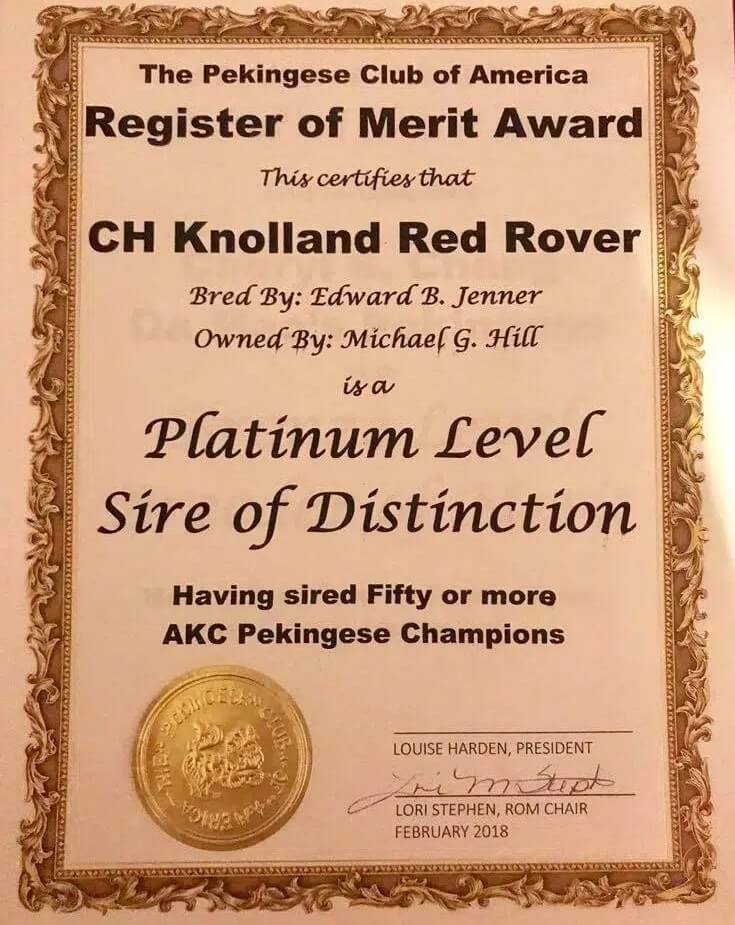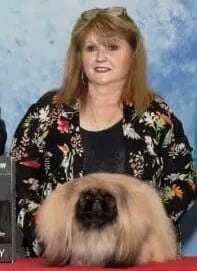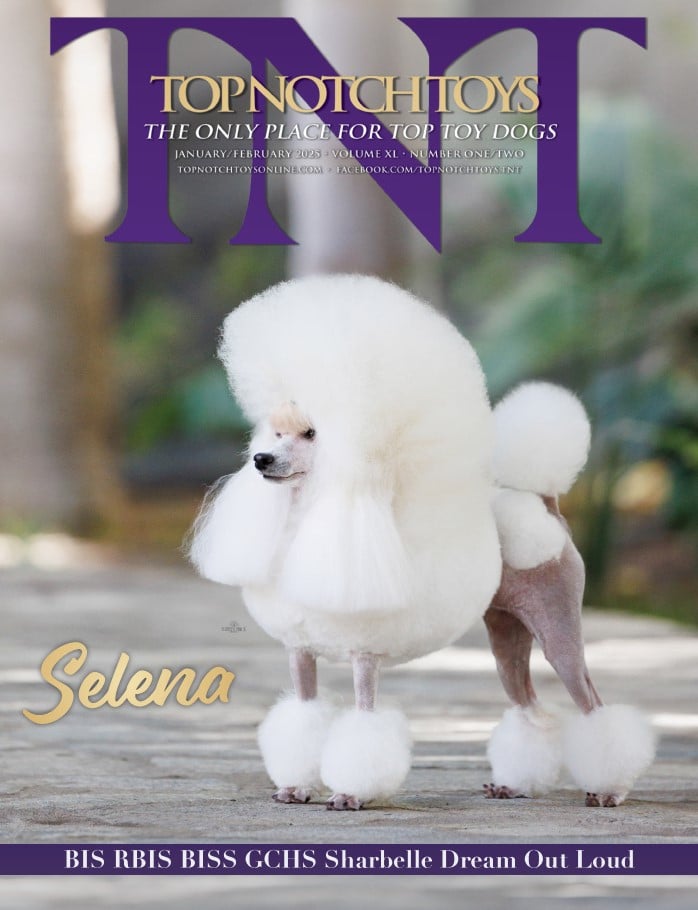The Age of Rover | A Conversation with Michael Hill. Who would have thought that a semi-casual inquiry about using CH Wendessa Crown Prince in an already successful breeding program would have resulted in Michael Hill purchasing what has probably been the most pre-potent sire of the decade?
After seeing Mr. Ed Jenner’s CH Wendessa Crown Prince at the Canadian Kennel Club Centennial Show in 1988, Michael Hill of Akarana Pekingese was rather impressed. “A grand and shapely body, firm and sturdy construction, and the desired tailset and carriage, and a great attitude.” Uncertain as to where to go for an outside breeding, as CH St Aubrey Laparata Dragon had died, Michael inquired about sending a bitch to Crown Prince. When asking about what Crown Prince had produced, Mr. Luc Boileu mentioned that he had sired a nice dog that had finished at the Chicago International Show with a Group Two. As Mr. Jenner and Mr. Boileu were keeping the litter sister, and concentrating on Crown Prince’s career, this young dog, CH Knolland Red Rover, would be staying home. At that time, Michael Hill asked if the dog might be available for sale. “….a few months later I met Luc under the tenting at a dog show and he pointed to the wire crate where the most beautiful, rich red dog was resting in a glorious cloud of coat and black fringing, intense pigment, and the blackest of eyes. I’ve never reached into my pocket and given anyone a check so quickly in my life. Luc was sure that I should take him out for a walk first. I wasn’t… he might change his mind!” And, the Age of Rover began.
What a classic pedigree this was! Six lines to Dragon in five generations through six DIFFERENT dogs, with the combinations of half brother-sister, grandsire-granddaughter, and a grandson-daughter. On paper, it was flawless. Simply from looking at the pedigree, one would assume that what Rover would produce [would be] typical of his relatives. When Rover arrived in Canada, he had already sired two litters; Knolland Red Robin and Knolland Red Rueben, both destined to become champions and great producers in their own right, and what was to become Roger and Judy Sankey’s first homebred champions, Sanrae Second to None, Sanrae Head of the Class, and Sanrae Delta Dawn, all of which have gone on to produce champions. “I quickly realized that it was not that there were one or maybe two good puppies in a litter, but that entire litters were quality. To date, it looks like there have been eleven All-Champion litters sired by Rover.”
And, the Age of Rover began.
What a classic pedigree this was! Six lines to Dragon in five generations through six DIFFERENT dogs, with the combinations of half brother-sister, grandsire-granddaughter, and a grandson-daughter. On paper, it was flawless.
Much can be said about how a sire of this magnitude occurs. Possibly, it is a combination of being the right dog at the right time and in the right place. As to the right place, some may not have considered a small kennel in Canada the right place, but it certainly did not deter many American and Canadian breeders from sending their best bitches to be bred to this little red dog. “I made Rover as available as possible and at a moderate fee. My parents had taught me that as a breeder, one has a responsibility to the breed when one is in a fortunate position to make the right animal available to suitable breeders. There are some that do not share that thought, and I can well understand their viewpoint and reasonings behind it, but I do think we must cast our thoughts to where the breed would be if dogs such as CH Dragon had not been made available, or in Great Britain, CH. Ku Jin or CH
Yu Yang.”
The Akarana kennel is not one to keep a dog out on an extended show career. In spite of this, Rover finished his Canadian championship with three Group Firsts and an All-Breed BIS. The following year, he was #2 Toy dog in less than half the number of shows as the #1 and #3 Toy dogs. He also captured the Toy Group at Canada’s Show of Shows. Twice, he won the Group, with his daughters taking Best Puppy in Group.
I made Rover as available as possible and at a moderate fee. My parents had taught me that as a breeder, one has a responsibility to the breed when one is in a fortunate position to make the right animal available to suitable breeders.
When asked to talk about Rover as a show dog, after a few snorts and rolled eyes, the response I got was; “Wonderful and… infuriating! He was never out of coat. I am not a fan of trimming, but every five or six weeks, I would have to get rid of an inch or so of coat and have it appear that Rover had not been anywhere close to scissors. Rover was always calm and self-contained. He has one speed and one style, and nothing, absolutely nothing would change that. He would never drop his tail, never move faster, and never move slower. He was so convinced of his self-importance that he took the most arrogant of attitudes.”
Looking at the total number of puppies produced by Rover, and keeping in mind that not all of his puppies have been exhibited, somewhere in excess of 70 percent or 104 have finished their championships. His children lay claim to fifty-one Canadian Championships, one English Championship, fifty-two American Championships, ten American Group Firsts, eighteen Canadian Group Firsts, five American All-Breed Bests in Show, seven Canadian All-Breed Bests in Show, eleven Bests in Specialty Show, and three Pekingese Club of America Bests of Breed.
His accomplishments in England were not so much in the show ring, but in what his son, Am. Can. Eng. Champion Rodari Orient Express produced. “Bobby,” who completed his English title very quickly under the guidance of Winifred Mee, sired Eng. CH Tenling Golden Arrow of Pekehuis—Sire of the Year for four years—who went on to sire Eng. CH Pekehuis Pure Gold, another Top Sire of the Year. Sadly, Bobby’s exposure as a sire was cut short by his breeder’s decision to sell him to the Orient. However, even with such a brief stay in England, he managed to leave his mark; there were six consecutive generations of English champions descended from Rover, with the seventh generation in the wings at this original writing more than 18 years ago. On another interesting note, Rover himself carries Pekehuis blood through two bitches.
What about Rover as a companion and housemate? “His most endearing quality is his bloody-minded strength of character and attitude. When he has something fixed in his mind, he cannot be swayed from it. Of course, this is exactly what I love about the breed. I love Pekes of infuriatingly strong character, the ones who want their own way and take great determination to get under control for the ring. But, Rover is a quietly loving dog. Not demonstrative in nature, he nevertheless enjoys being hugged and cuddled and a gentle game.”
What else can you say about such a grand little dog? He was well-loved by Michael Hill, and his intense personality captured the hearts of most who came into contact with him. I had the privilege of meeting Rover years ago, and make no mistake; it was a little red dog that ruled the Hill household in Toronto.
On July 22, 2000, the Age of Rover came to an end. At just a few days past his 13th birthday, Rover departed this life. But, what a legacy this one little red dog left behind!
Michael commented “…I have had many messages from all ‘round the world, literally. I take much comfort in seeing him in the wonderful descendants bred by so many talented and caring breeders who have his blood. My personal loss was no more nor any less than others who’ve lost their much-loved companions and suffered the same sadness. Just that Rover was more of a public dog.”
The Pekingese fancy owes a debt of gratitude to Rover’s talented breeder, Ed Jenner, and to his owner, Michael Hill, for making Rover available.
Rover, you are sorely missed. But we will see you for generations yet to come.










